How much does it cost to tune my piano?
September 17, 2021 •Stephen Reed
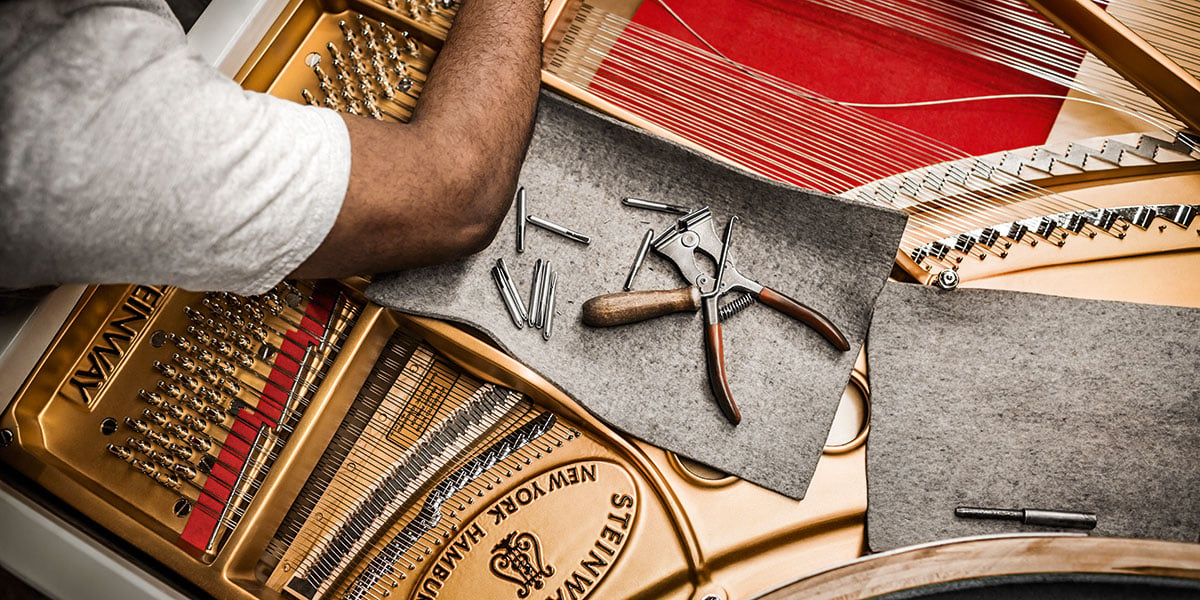
Keeping one’s piano in tune is a major responsibility of owning a piano. Much is at stake when you don’t keep your piano well-tuned. Later maintenance brought on by neglect can be a more expensive proposition than regular tuning.
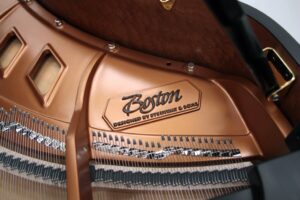
In this article, we will illustrate how the different elements involved in keeping your piano well-tuned are a fraction of the cost involved in neglecting its tune.
Since 1860, M. Steinert & Sons has been supporting its customers by advising regular tuning of their pianos for optimum performance, whether in the home or the concert hall.
Keeping one’s piano well-tuned simply goes with the territory of owning a fine musical instrument. The good news is that, once you find a competent piano technician, a solid, regular tuning can be given at a rather reasonable cost.
If needed, piano technicians can oftentimes provide other services like regulation that are important for the mechanical upkeep of your piano. This keeps your piano in top shape, both mechanically and in terms of its overall tone.
Cost range for a piano tuning
Today, the cost for a good piano tuning can range from $140 to $300. Additionally, a pitch correction is sometimes available for under $100.
Tuning by ear vs. electronic technology
Aurally
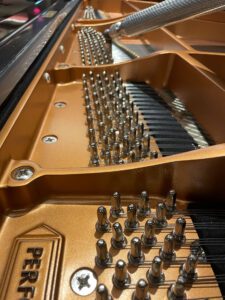
Traditionally, a piano technician would tune aurally, that is, by ear. First, they take some strip mutes made of red felt to mute the outside of the strings to allow them to listen to just one string at a time.
Each string is wound around an individual tuning pin, which is what keeps the string tight. Some piano technicians use only a tuning hammer and a tuning fork. The technician hits the tuning fork, then places it on one of the strings. The technician then plays the key, attempting to match the two sounds.
At this point, the tuning hammer is placed on one of the tuning pins. The piano technician will turn the pin with a tuning hammer to the right to make the key sharper and to the left to make it sound flatter. The technician literally “plays it by ear” until they have the key tuned correctly.
But this isn’t an average person’s ear. A well-regarded piano technician has an ear that recognizes correct pitch from a combination of musical giftedness with increasing experience working on pianos.
Electronic technology
While many aural piano technicians can still be found, most piano tuners use chromatic tuners today. At the beginning of a piano tuning, the technician will use it to set the first string to make sure the piano is on pitch. But the chromatic tuner can’t be used to tune the whole piano, due to the nature of the piano’s strings

A string vibrates between two fixed points by vibrating through sections of its length--whole, half, one-quarter, and so on. These vibrations create overtones along with the overarching frequency. For example, the A below Middle C, which has a frequency of 220Hz, will also produce overtones of 440Hz, 660Hz, 880Hz, and so on.
Because a piano string is somewhat stiff, these resulting overtones sound higher in pitch than they should be, in theory. The piano technician matches the overtones of lower notes to the basic pitch of higher notes. The result is “stretch,” here defined as the octaves coming out wider than they theoretically should be.
“Stretch” is why a chromatic tuner can’t be used to tune a whole piano. While the chromatic tuner would give frequencies that are theoretically correct, it doesn’t take into account the stretch with the overtones. Still, an increasing number of modern software applications are able to factor in a suitable stretch.
Which is the better approach?
The use of electronic technology in a venerable field like piano tuning has taken time to gain acceptance, though again, most piano technicians today use some technology to supplement their aural skills.
One area that set back electronic devices like the chromatic tuner was the now-debunked notion that an unskilled person could become a competent piano technician simply by using a chromatic tuner. Not true.
However, in the hands of a skilled piano technician, a chromatic tuner can be used quite effectively. The technician can double-check their aural results against the chromatic tuner.
Piano tuning is a highly specialized technical field. Whether or not they use aural methods only or draw upon an electronic tuning device, you are paying for a competent piano technician’s skill and experience. This will become clearer when we discuss the price for a good piano tuning below.
Two key parts in tuning: Strings and the soundboard
Many strings, much tension
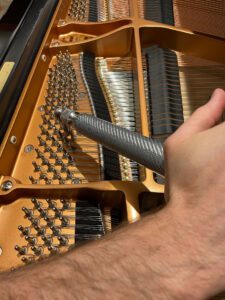
Most pianos have 230 strings. When you consider that each string is stretched to between 150-200 lbs of pressure, together with the heavy wooden framing, the total pull is nearly 20 tons.
One of the most common reasons for a piano tuning is to tune and tighten the strings to elevate the pitch up to a vibrating frequency of the international standard of A440. A440 is the standard by which the A above middle C is tightened enough to vibrate to 440 Hz, that is 440 times per second.
Tuning is the task of making the string tension of each of the 230 strings correctly harmonize with one another.
New pianos need tuning up to four times during the first year after purchase since wooden parts settle and new strings stretch.
After the first year, one or two tunings per year keep the strings in proper tension, unless seasonal change requires an additional tuning. The Sitka spruce soundboard can be affected by such seasonal changes.
Understanding the changing soundboard
As the main acoustical part of the piano, the soundboard’s seasonal change is critically important to note.
According to Jonathan Kotulski, M. Steinert & Sons’ piano technician, in more humid seasons, the soundboard can swell with water as humidity rises. This increases its shape and causes the piano’s stretched strings to have a higher pitch.
Jonathan notes that in drier seasons like winter, the soundboard deflates and the strings naturally lower their tension and their pitch. This ebb and flow of humidity throughout the year can sometimes bring on the need for additional tunings.
Read more about Jonathan’s perspective on humidity and pianos in Do I need a piano humidity control system?
More costs involved without tunings
So what’s the worst that can happen if you neglect to tune your piano regularly?
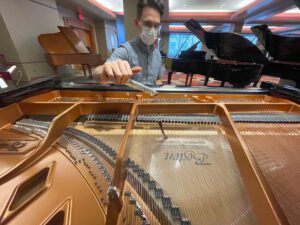
Plenty, actually. For example, strings can break from the increasingly flat tension in the strings that have not been tightened regularly.
Moreover, the beautiful instrument you’ve invested in will not sound like the one you bought, It will sound increasingly substandard.
If the strings deteriorate too much, or if the strings are out of tune and not actively used, then the piano may have to be restrung, which can sometimes cost as much as buying a new piano.
It is important for those learning to play the piano to have an instrument that is in tune so they can correctly learn the pitches.
If a piano player learns to play with incorrect pitches, it will hinder his or her ability to play a tuned piano, because the pitch will sound off to them.
A well-tuned piano helps the young student of the piano, giving them greater confidence from playing an instrument that sounds the way it should. Kids are more likely to keep playing a well-tuned piano.
Finally, your piano will be more likely to stay in tune well in its later years because of the good tunings given it in its early years. This is a simple matter of maintaining one’s investment.
Summary: Tuning yields a lot for a little
Tuning one’s piano yields a disproportionate benefit for the cost involved. For a modest outlay of time and money, your piano will sound on pitch. The overtones of the piano’s lower notes are married to the basic pitch of higher notes. Your piano is ready to be played.
Read more about the pianos available at M. Steinert & Sons:
Featured Articles
Categories
- Beginner Pianos (23)
- Boston Pianos (15)
- Comparisons (30)
- Designer and Specialty Pianos (8)
- Essex Pianos (10)
- Events (11)
- Featured (24)
- Institutional (3)
- Joy of Piano (15)
- Learning About Pianos (69)
- News (35)
- Pricing and Cost (19)
- Resource Center (122)
- Roland Pianos (6)
- Spirio (15)
- Steinway Pianos (70)
- Student (14)
- Teacher (13)
- Used Pianos (20)
- Videos (19)

